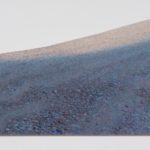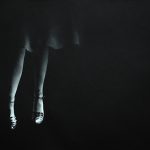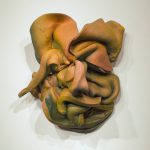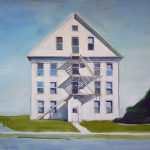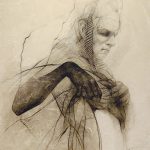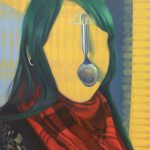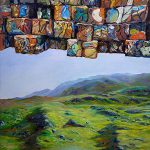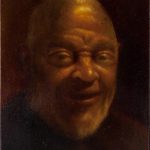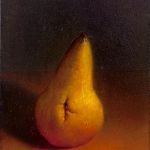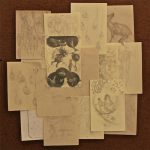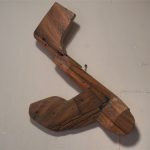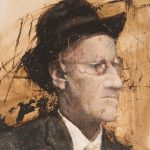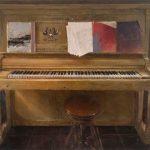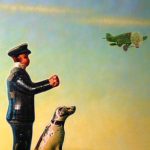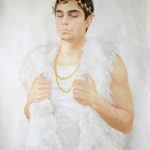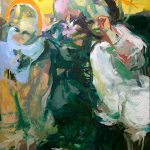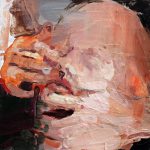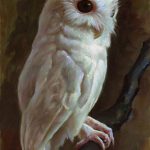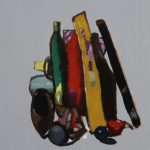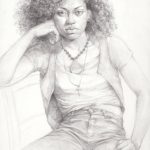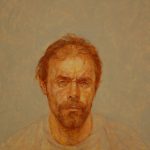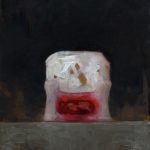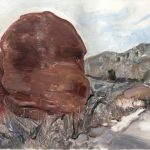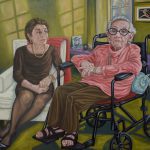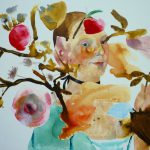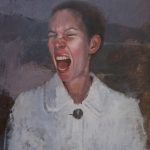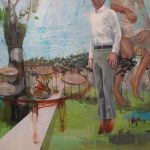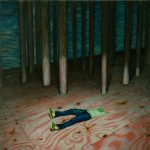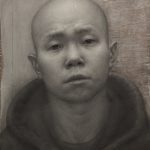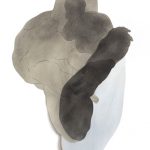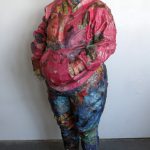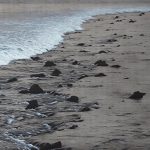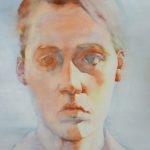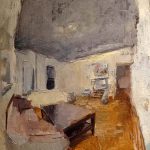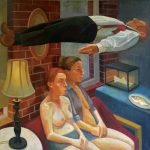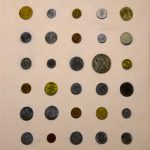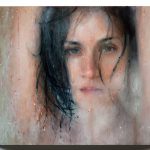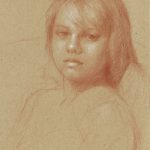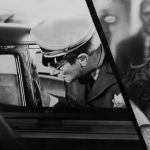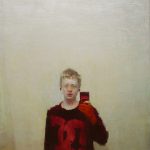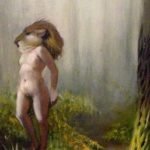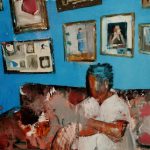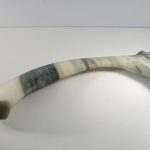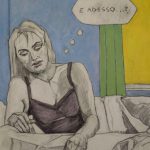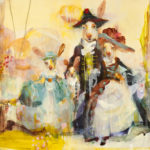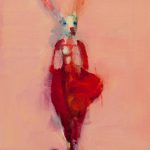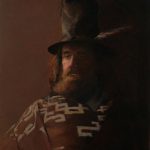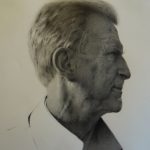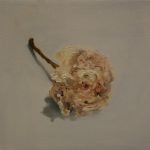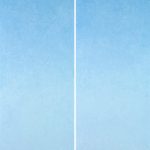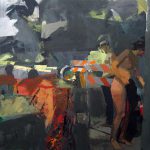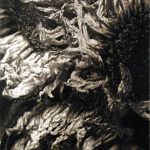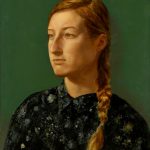Relearning How to Exist
Participating in a residency in Shanghai is unlike anything we have experienced. China is unique because of our lack of familiarity with contemporary Chinese culture, customs, and language barriers. The process of trying to make sense of this new world is a phenomenological undertaking. Our thoughts and needs are communicated via hand gestures, pictures, electronic devices or a third party–who may selectively translate what we are saying.
In the text, Being and Time by Martin Heidegger, dealing with the nature of existence is explored; “Being cannot be grasped except by taking time into consideration, the answer to the question of being cannot lie in any proposition that is blind and isolated”. As we experience life in China we can only open ourselves to the supreme novelty of the residency. Our experiences do not need to be made sense of in the moment, but rather, this is an opportunity to gather information. To truly understand something one must surrender preconceived notions about what could or should happen. One must simply Be and experience life as it is in the moment, and only in hindsight, we can reflect upon what we learned.

Being here is a wonderful opportunity to learn. One of the most curious aspects that I have found deals with the arrangement of space. Architecture in Shanghai is bold and imposing. Each grouping of buildings appears to be based on one Architectonic model, which is repeated a number of times. The lumping of structures divides the city into a series of rhyming blocks of buildings, which is followed by a vast expanse of flat land that extends forever.

The traditional city of Hangzhou is what one might imagine of China in the early 20th Century to be. We hiked through a bamboo forest to the top of a mountain. We looked down through the clouds to see an impression of the city, and a tea farming town in the distance. While walking the countless steps to the Pagoda atop the mountain, I kept thinking about the overall composition of traditional Chinese ink drawings. In them the viewer experiences space not in terms of linear perspective, but as a holistic impression of how space feels.
 One day Wang Yi took us to the opening of “Return to Simplicity“, a retrospective of Wu Shanming’s work, I realized that climbing the mountain actually felt like the works we saw at the Zhejiang Art Museum. Shanming’s oeuvre was comprised of variations of wash drawing techniques. He answered questions regarding the use of color as a compositional device, where to crop an image, where to simplify, and where to allow the abstract nature of the medium to flow, for the sake of creating an image that is captivating and sensitive.
One day Wang Yi took us to the opening of “Return to Simplicity“, a retrospective of Wu Shanming’s work, I realized that climbing the mountain actually felt like the works we saw at the Zhejiang Art Museum. Shanming’s oeuvre was comprised of variations of wash drawing techniques. He answered questions regarding the use of color as a compositional device, where to crop an image, where to simplify, and where to allow the abstract nature of the medium to flow, for the sake of creating an image that is captivating and sensitive.  China is a land of many joys, such as the pleasure of truly getting to know fellow residents, as people and as Artists. Our weekly critiques have been challenging at times, and yet because of the respect we have developed for each other, and because of the fact that we are all mutually invested in the success of the other’s work, positive changes are happening in the studio. This residency has benefited us not only in studio time, and cultural learning, but also in the freedom to sit and read. I find myself reflecting on a quote by Nietzsche, in Thus Spoke Zarathustra, “You teach that there is a great year of becoming, a prodigy of a great year; it must, like a sand-glass, ever turn up anew…” The challenge understanding a place so detached from Western Culture is that we are forced to rethink ourselves, not just as the character we know ourselves to be, but as artists, whose work is eternally evolving, influenced by our surroundings and stimuli.
China is a land of many joys, such as the pleasure of truly getting to know fellow residents, as people and as Artists. Our weekly critiques have been challenging at times, and yet because of the respect we have developed for each other, and because of the fact that we are all mutually invested in the success of the other’s work, positive changes are happening in the studio. This residency has benefited us not only in studio time, and cultural learning, but also in the freedom to sit and read. I find myself reflecting on a quote by Nietzsche, in Thus Spoke Zarathustra, “You teach that there is a great year of becoming, a prodigy of a great year; it must, like a sand-glass, ever turn up anew…” The challenge understanding a place so detached from Western Culture is that we are forced to rethink ourselves, not just as the character we know ourselves to be, but as artists, whose work is eternally evolving, influenced by our surroundings and stimuli.
Marble’s Elusive Fruit
By Steve Shaheen (MFA 2005)
This is the world of contemporary stone sculpture, at least to those of us remaining who do our own work. It’s not for everyone.
But Heena Kim (MFA 2014) and Josh Henderson (MFA 2015) have assimilated disconcertingly well into this severe and otherworldly gulag. After the first few days I realized they were hopelessly corrupted, and no dust or noise or consternating technical hurdle would sway them. Something about the beauty of the material, the direct engagement with it, the challenge of the process–as well as the hope for what it might someday become–holds a transfixing allure for those who taste of marble’s elusive fruit. Heena and Josh are approximately halfway through their pieces. In general, however long it takes you to rough out and model your forms on a stone sculpture, you can calculate the same time to rasp, sand and finish the work. While accolades are premature, Heena and Josh have so far done exceptionally well. After four years of leading this residency (Quentin McCaffrey 2011, Joseph Brickey 2012, Heather Personett and Zoe Swenson-Taylor 2013), I feel spoiled by Academy students’ level of preparedness and their ability to jump into one of the most technically challenging media available to artists.
Steve Shaheen
###
A Fish Out of Water
 By Claire Cushman MFA 2015
By Claire Cushman MFA 2015In the early hours of Monday, June 9th, eleven half-asleep Academy students trudged through the rain to Grand Central Station, dragging bags heavy with clothing and paint supplies. After what I’m told was a scenic two-hour train ride along the Hudson River, we arrived in Rhinecliff, New York, where staff members Katie Hemmer and Denise Armstrong met us with two vans. We piled in, and headed to Germantown’s “Central House” B&B, which would be our home for the next four nights and five days.
This summer marked the New York Academy of Art’s second Hudson Valley Plein Air painting residency, which affords students the opportunity to paint in the idyllic region in which the Hudson River School painters once worked. Founded by Thomas Cole, the original Hudson River School was the first painting school native to the United States and rose to prominence in New York City in the early 19th Century. The work was grounded in a celebration of the American landscape and the notion that nature was a powerful resource for spiritual renewal which led them to paint carefully observed, reverential, and sometimes idealized paintings of the Hudson River Valley and surrounding locations. Our retreat, led by faculty member Catherine Howe, offered a very welcome change of scene after a full year of toiling in our Franklin Street studios.
 After settling into Central House (which we had entirely to ourselves), we drove to the nearby Clermont State Historic Site. The site protects the former estate of the Livingston family, and is named for its clear view of the Catskill Mountains over the Hudson River. Catherine met us in the visitor center (a small cottage that served as our painting base camp). She sprayed us thoroughly with bug spray and made us promise to conduct nightly tic checks on each other, then took us on a tour of the grounds. We made our way through an “allée” of enormous trees, past a bountifully flowering garden, by a pet cemetery with a gravestone from 1902, to the Livingston mansion. Rolling green hills surround the mansion, giving the property the feel of a golf course.
After settling into Central House (which we had entirely to ourselves), we drove to the nearby Clermont State Historic Site. The site protects the former estate of the Livingston family, and is named for its clear view of the Catskill Mountains over the Hudson River. Catherine met us in the visitor center (a small cottage that served as our painting base camp). She sprayed us thoroughly with bug spray and made us promise to conduct nightly tic checks on each other, then took us on a tour of the grounds. We made our way through an “allée” of enormous trees, past a bountifully flowering garden, by a pet cemetery with a gravestone from 1902, to the Livingston mansion. Rolling green hills surround the mansion, giving the property the feel of a golf course.
The next day, we ventured to Olana, once Frederic Church’s home and studio. Church, the predominant painter of the Hudson River School’s second generation, travelled extensively throughout Europe and the Middle East, and drew inspiration from the design he saw while abroad. Scenic carriage roads lead to Olana, which perches atop a hill overlooking the Hudson River valley and Catskill Mountains. The mansion’s ornately stenciled stone and brick façade is a mixture of Victorian, Persian and Moorish architecture. The interior remains lavishly decorated, as it was during Church’s lifetime. Bird feathers, Persian rugs and tapestries, sketchbooks, unique amber stain glass windows, and other eclectic objects, which Church acquired on his travels, fill the house to the brim. Hanging on the walls are over forty paintings by Church and his friends.
Thankfully, we had some sunshine while at Olana, and could clearly see Church’s stunning view of the Hudson River Valley. With the weather forecast clear for the whole afternoon, I was excited to get back into landscape painting, especially after focusing on the human figure for the school year.
Before starting at the Academy, I primarily painted landscapes. However, not having painted outside for nearly a year, I felt like a beginner when I began putting brush to canvas on this retreat. And on top of the unfamiliar subject matter, there were the challenges of painting outdoors. The plein air painter must contend with fickle weather, bugs, the annoyance of carrying one’s supplies around while finding a good spot to paint, and ever-shifting light. While at Olana, I couldn’t help but wonder how on earth the Hudson River School painters were able to create the meticulous work they did without the aid of photographs.
Although I felt like a fish out of water at first, I also found that what I had learned during my first semester perceptual painting class at the Academy deeply informed my landscape painting. This class (which I took with Dik Liu) made me think much more carefully about color temperature and spatial relationships, and has given me a far organized approach to painting from life. It was truly exciting to feel like I could put what I had learned this year to use “out in the real world” during the Hudson Valley residency. I highly recommend this retreat to all and any academy students next year.
###
Claire Cushman (MFA 2015) participated in a week-long residency in Hudson Valley, New York where she and Academy artists Jaclyn Dooner (MFA 2015), Patricia Horing (MFA 2015), Richard Alex Smith (MFA 2015) Rachel Birkentall (MFA 2015) , Shaina Craft (MFA 2015), Todd Eisinger (MFA 2014), Daniel Dasilva (MFA 2015), Kiki Carrillo (MFA 2015), Kerry Thompson (MFA 2014), and Ian Factor (MFA 2014) experienced a pastoral splendor that has enticed American artists for centuries.
Creating Memories We’ll Never Forget
Here is a video compilation of the various happenings we’ve had the incredible opportunity to be a part of in Germany. The video takes a look at our home and studio life at the Leipzig Spinnerei; critiques with other artists-in-residence; a trip to Berlin to see the Käthe Kollwitz Museum and the Gemäldegalerie at the Kulturforum; an art opening on Karl-Heine-Straße, a visit with Berlin artist, Ruprecht Von Kaufmann, and a tour of the Schloß Castle in Machern. We’ve had the pleasure of celebrating birthdays (Camila’s, Piper’s and Matt’s), and creating fun memories that we will never forget like beating eggs with a whisk attached to a power drill, snoring on the bus, and of course, lots of meals filled with hefeweizen and bratwurst. Enjoy!
Moscow Residency Part 1: A City of Irrepressible Spirit
“Russian people are altogether spacious people, just like their land, and extremely inclined to the fantastic and disorderly” – from Fyodor Dostoyevsky’s Crime and Punishment.
It’s a bit difficult to grasp how so much has been given to us for this residency. I’m in awe of the opportunity organized by the incredibly generous and well-connected Nikolay Koshelev (MFA 2014). To be completely honest I’m a little apprehensive about the responsibility that this opportunity implies.
While soaking in the sights and sounds in our new cozy and lived-in studio, we received a welcome interruption to our reverie from Nikolay who introduced us to artist friends he had invited. Not long after that, we were all sharing food and conversation at a French café, followed by a nighttime stroll through the monumental Red Square – an open rectangular stretch of cobblestone surrounded by the Kremlin, the State Historical Museum, an absurdly large department store, and the iconic St. Basil’s Cathedral. The grandiosity of the scenery, coupled with the sudden familiarity and comfort brought by our new friends, gave these moments what I felt to be a distinctly Russian sense of frivolity, bound by a mutual understanding of comradery. How naturally we fell into a comfortable group dynamic, bridging a cultural gap thousands of miles long. The moment we finally arrived back to our castle apartment around 4 in the morning, the sky was turning blue, and our conversation focused intently on how lucky we are to be here.
Last Monday, we had our first visit to the Tretyakov Gallery, a museum stocked with the most beautiful and emotive landscape paintings I’ve ever seen, and we can copy any painting we choose on a weekday when the museum is officially closed, but seemingly entrusted to us. Soon we will make a trip to St. Petersburg to visit the Hermitage Museum, one of the largest museums in the world, with the largest collection of paintings.
After settling into our new surroundings we’ve begun to make a habit of working in the studio every day, slowly but surely building momentum that I hope will culminate in a series of paintings that accurately reflect the air of grandeur and whimsy that permeates this city, and the generosity and open soul of its people.
It Felt As If We Were Inside A Traditional Chinese Painting
By Dana Kotler MFA 2015

on my work.
###
On May 26, four Academy students departed New York for a six-week residency in Shanghai. Tamalin Baumgarten, Dana Kotler, Arcmanoro Niles, and Ryan Schroeder (all members of the MFA class of 2015) will share their experiences here throughout the summer.
Finally, Some Progress
Josh Henderson is one of two Academy students learning the ways of stone carving during a summer residency at the Studio Corsanini in Carrara, Italy. The residency made possible by ABC Stone aims to promote the use of stone in artistic practice by pairing young artists with master sculptors for experimental learning through intensive mentoring. As a neophyte stone carver, Josh’s learning curve is as steep as the mountains that surround him. While it may seem that time no longer qualifies as a valid measurement of progress, Josh’s biggest triumph has been learning the lesson of patience.
Get a glimpse of life in Carrara as Josh takes us through one stone cold day at the studio:
Joshua Henderson (MFA 2015) writes:
Finally! After many days of carving stone at Studio Corsanini in Carrara, Italy, I’ve made enough progress to show something. However, it’s still really rough. It’s probably the equivalent ten minutes of drawing or some ridiculous thing like that. Just imagine how much longer finishing the carving process would be. Here’s how it all begins:
Surviving Generations and Wars: Part of Leipzig’s History
|
Dreaming big (and getting a little jealous too) in front of Olafur Eliasson huge studio in Berlin.
|
 We were greeted at Spinnerei by Kristina Seminova (LIA program coordinator, an amazing and intelligent Russian woman, who knows all). In the few first days, she explained the history of where we were staying. The old cotton mill factory had survived generations and wars to become one of the most important centers of art, artists residencies, studios and galleries in Germany. Today big names like Neo Rauch, Oliver Kossack, Rosa Loy and many others are residents of this factory complex.
We were greeted at Spinnerei by Kristina Seminova (LIA program coordinator, an amazing and intelligent Russian woman, who knows all). In the few first days, she explained the history of where we were staying. The old cotton mill factory had survived generations and wars to become one of the most important centers of art, artists residencies, studios and galleries in Germany. Today big names like Neo Rauch, Oliver Kossack, Rosa Loy and many others are residents of this factory complex.We have two independent artists in the residency with us, Piper Mavis a visual artist form Los Angeles/CA and Francis Morgan, a Berlin based painter from Australia. I have to confess that part of the success of this trip is because of them. They happily motivate us with the energy that they emanate. Their critiques and feedback on art outside of the school have been very helpful in making us think more maturely about our studio practices. I feel that I’ve learned so much from them. Their confidence is very inspiring. Frankie has the most marvelous sayings: “One of my goals is channeling my emotions into paint instead of fucking up someone’s day”. And whatever impression that gives you, it’s yours to take. How honest is that?
With a full calendar of events and activities, I can’t wait to share more and tell you about our studio practices and excursions around Leipzig and to Berlin. I had to visit Berlin to get my visa renewed and I found a little time to visit a museum close to the bus central station– The Grunderzeit Museum. This museum was created by Charlotte Von Mahlsdorf and it shows the art collection of the family. I found a very humble list of artists that I had never heard of before. What a fascinating visit. We also went as a group to visit the Neue Galerie and David Bowie Exhibition curated by the Victoria and Albert museum in England. In my next post, I will tell you about all this and more!
###
Camila Rocha is joined by Matthew Comeau, Esteban Ocampo and Hannah Stahl in Leipzig, Germany for a two-month Residency. On the Academy’s blog, the students will share their adventures abroad throughout the summer. Return here for updates and more from Germany.
2014 Summer Exhibition
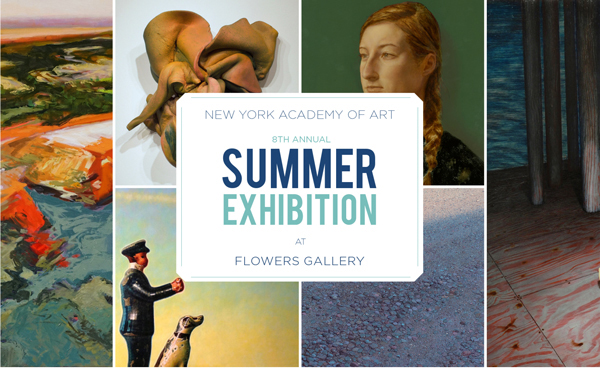
CURATED BY
MATTHEW FLOWERS, Flowers Gallery
LAURA HOPTMAN, Museum of Modern Art
PATTERSON SIMS, Independent Curators International
Artwork above by:
Alfonso Gosalbez, Cori Beardsley, Shangkhai Kevin Yu, John Jacobsmeyer, Peter Drake and Emily Adams
- Emily Davis Adams (MFA 2011, Fellow 2012)
- James Adelman (MFA 2014)
- Craig Banholzer (MFA 2003)
- Corinne Beardsley (MFA 2011)
- Carrie Bobo (MFA 2009)
- Ilsa Brittain (MFA 2014)
- Dina Brodsky (MFA 2006)
- Dina Brodsky (MFA 2006)
- Alicia Brown (MFA 2014)
- Zach Brown (MFA 2013)
- Thomas John Carlson (MFA 2006, Fellow 2007)
- Miguel Carter-Fisher (MFA 2012)
- Miguel Carter-Fisher (MFA 2012)
- Jeffrey Casto (MFA 2004)
- Aleah Chapin (MFA 2012, Fellow 2013)
- John Coburn (MFA 1997)
- Garrett Cook (MFA 2014)
- Garrett Cook (MFA 2014)
-
Adam Cross
MFA 2014
- Peter Drake (Dean of Academic Affairs
- Heidi Elbers (MFA 2010)
- Samuel Evensen (MFA 2006, Faculty)
- Megan Ewert (MFA 2013)
- Shauna Finn (MFA 2005)
- Steve Forster (MFA 2010)
- Meg Franklin (MFA 2013)
- Elizabeth Glaessner (MFA 2013, Fellow 2014
- Alfonso Gosalbez (MFA 2014)
- Ava Harel (MFA 2007)
- Ava Harel (MFA 2007)
- Jacob Hayes (MFA 2014)
- Erinn Heilman (MFA 2015)
- Ivy Hickam (MFA 2013)
- Madeleine Hines (MFA 2014)
-
Patty Horing
MFA 2015
- Holly Hudson (MFA 2010)
- Daniel Hughes (MFA 1995)
- Caitlin Hurd (MFA 2006)
- John Jacobsmeyer (Faculty)
- Yunsung Jang (MFA 2013, Fellow 2014)
- Christian Johnson (MFA 2001)
- William Kurtz (MFA 2009, Fellow 2010, Faculty)
- Lisa Lebofsky (MFA 2006)
- James Linkous (MFA 2013)
- Lisa Manley (MFA 2013)
- Lisa Manley (MFA 2013)
- Benjamin C. Martins (MFA 2011)
- Ayumi Matsuba (MFA 2010)
- Curtis Mcdowell (MFA 2009)
- Ge Mei (MFA 2014)
- Elizabeth Misitano (MFA 2011)
- Alyssa Monks (MFA 2001)
- Livia Mosanu (MFA 2015)
- Mark Paczkowski (MFA 2013)
- Eric Pedersen (MFA 2015)
- Eric Pedersen (MFA 2015)
- Laura Peturson (MFA 2005)
- Elena Rodz (MFA 2011)
- Nicolas V. Sanchez (MFA 2013, Fellow 2014)
- Stephen Shaheen (MFA 2005)
- Alissa Siegal (MFA 1993)
- Susan Siegal (MFA 2010)
- Susan Siegal (MFA 2010)
- Robert Silverman (MFA 2006)
- Jesse Stern (MFA 2012)
- Helen Strickler (MFA 2014)
- Daisuke Takeya (MFA 1995)
- Tim Tozer (MFA 1996)
- Tyler Vouros (MFA 2011)
- Shangkai Kevin Yu (MFA 2014, Fellow 2015)
Painting, Laughter and an Eagerness to Adapt
Our guide, Wang Yi, is a joy to get to know. We visited his studio last week. His paintings blew us away, reminding us of Michael Borremans and Adrian Ghenie. He took us to an art fair, the YUZ Museum, and his friend’s gallery called Ming Gallery, where his work is currently showing. We’ve been learning about the art market in China and how the collectors only buy old art that has already proven its value. People buy contemporary art for lower prices, not as investments, but for the purpose of decorating their homes. Also, there isn’t much of a market for international art yet. People here buy art that they are familiar with and are less likely to branch out into purchasing more conceptually based artwork.
The food here is a highlight. Our routine late dinners on the street excite us most. We walk across the campus along the dimly lit, tree-lined road, past the coy pond, through the finely mowed field, over the river bridge to a bustling outdoor array of food vendors. Dozens of venders grill and serve food on sticks. We enjoy trying new things and often order more than enough. We find amusement in each other’s eating habits and trying to communicate with the vendors for Arc and Dana to avoid pork, and nothing spicy for Dana, and “is there pork in the sauce?” or “what’s the little speck of meat on the broccoli?” Ryan will eat anything! He enjoys spice to the point of severe pain, and if we can’t finish something or don’t like it, we pawn it off onto him. It’s quite hysterical.
Along with our infrequent showers, we have become comfortable with a less sanitary lifestyle. Arc and I discovered our go-to lunch spot where we find the best kung pow chicken. Yesterday, while eating the dish, I found a little cockroach on my chopstick. Arc and I looked at each other, he wrapped the little guy up in a napkin, and we continued eating—enjoying it just the same. That evening, Ryan was sipping on his tea and reached in his mouth to remove a little long-horn beetle. We gathered around inspecting the beetle as Ryan continued enjoying his tea. None of us have gotten sick yet. We find laughter through our journey of learning a new perspective.
So far, our experience in Shanghai has been fulfilling—full of painting and laughter and an eagerness to adapt and to learn from each other.



















